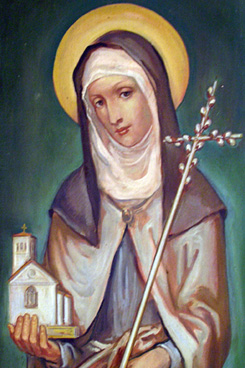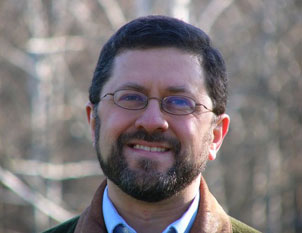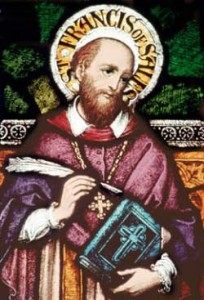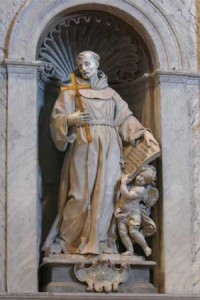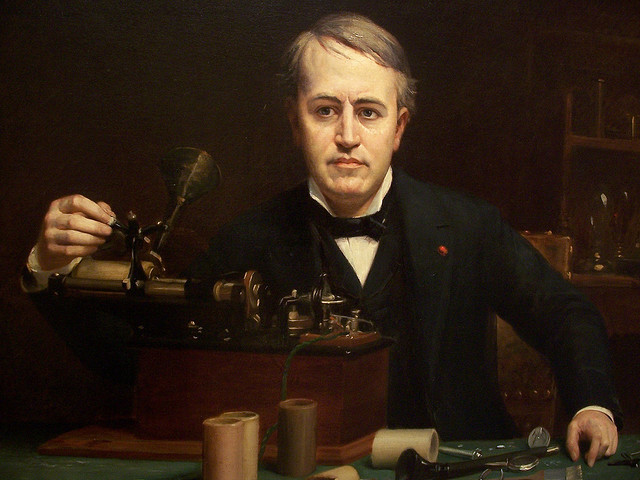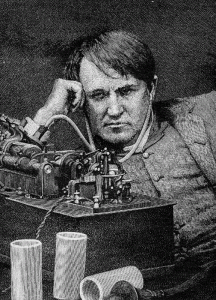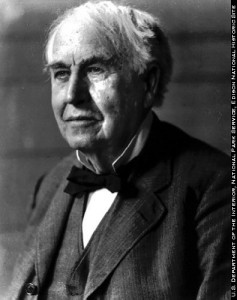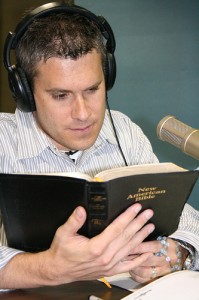Vatican City, Sep 15, 2010 Pope Benedict’s General Audience, from Vatican.va
Saint Clare of Assisi
Dear Brothers and Sisters,
One of the best loved Saints is without a doubt St Clare of Assisi who lived in the 13th century and was a contemporary of St Francis. Her testimony shows us how indebted the Church is to courageous women, full of faith like her, who can give a crucial impetus to the Church’s renewal.
So who was Clare of Assisi? To answer this question we possess reliable sources: not only the ancient biographies, such as that of Tommaso da Celano, but also the Proceedings of the cause of her canonization that the Pope promoted only a few month after Clare’s death and that contain the depositions of those who had lived a long time with her.
Born in 1193, Clare belonged to a wealthy, aristocratic family. She renounced her noble status and wealth to live in humility and poverty, adopting the lifestyle that Francis of Assisi recommended. Although her parents were planning a marriage for her with some important figure, as was then the custom, Clare, with a daring act inspired by her deep desire to follow Christ and her admiration for Francis, at the age of 18 left her family home and, in the company of a friend, Bona di Guelfuccio, made her way in secret to the Friars Minor at the little Church of the Portiuncula. It was the evening of Palm Sunday in 1211. In the general commotion, a highly symbolic act took place: while his companions lit torches, Francis cut off Clare’s hair and she put on a rough penitential habit. From that moment she had become the virgin bride of Christ, humble and poor, and she consecrated herself totally to him. Like Clare and her companions, down through history innumerable women have been fascinated by love for Christ which, with the beauty of his Divine Person, fills their hearts. And the entire Church, through the mystical nuptial vocation of consecrated virgins, appears what she will be for ever: the pure and beautiful Bride of Christ.
In one of the four letters that Clare sent to St Agnes of Prague the daughter of the King of Bohemia, who wished to follow in Christ’s footsteps, she speaks of Christ, her beloved Spouse, with nuptial words that may be surprising but are nevertheless moving: “When you have loved [him] you shall be chaste; when you have touched [him] you shall become purer; when you have accepted [him] you shall be a virgin. Whose power is stronger, whose generosity is more elevated, whose appearance more beautiful, whose love more tender, whose courtesy more gracious. In whose embrace you are already caught up; who has adorned your breast with precious stones… and placed on your head a golden crown as a sign [to all] of your holiness” (First Letter to Blessed Agnes of Prague: FF,2862).
Especially at the beginning of her religious experience, Francis of Assisi was not only a teacher to Clare whose teachings she was to follow but also a brotherly friend. The friendship between these two Saints is a very beautiful and important aspect.
Indeed, when two pure souls on fire with the same love for God meet, they find in their friendship with each other a powerful incentive to advance on the path of perfection. Friendship is one of the noblest and loftiest human sentiments which divine Grace purifies and transfigures.
Like St Francis and St Clare, other Saints too experienced profound friendship on the journey towards Christian perfection. Examples are St Francis de Sales and St Jane Frances de Chantal. And St Francis de Sales himself wrote: “It is a blessed thing to love on earth as we hope to love in Heaven, and to begin that friendship here which is to endure for ever there. I am not now speaking of simple charity, a love due to all mankind, but of that spiritual friendship which binds souls together, leading them to share devotions and spiritual interests, so as to have but one mind between them” (The Introduction to a Devout Life, III, 19).
After spending a period of several months at other monastic communities, resisting the pressure of her relatives who did not at first approve of her decision, Clare settled with her first companions at the Church of San Damiano where the Friars Minor had organized a small convent for them. She lived in this Monastery for more than 40 years, until her death in 1253. A first-hand description has come down to us of how these women lived in those years at the beginning of the Franciscan movement. It is the admiring account of Jacques de Vitry, a Flemish Bishop who came to Italy on a visit. He declared that he had encountered a large number of men and women of every social class who, having “left all things for Christ, fled the world. They called themselves Friars Minor and Sisters Minor [Lesser] and are held in high esteem by the Lord Pope and the Cardinals…. The women live together in various homes not far from the city. They receive nothing but live on the work of their own hands. And they are deeply troubled and pained at being honoured more than they would like to be by both clerics and lay people” (Letter of October 1216:Â FF, 2205, 2207).
Jacques de Vitry had perceptively noticed a characteristic trait of Franciscan spirituality about which Clare was deeply sensitive: the radicalism of poverty associated with total trust in Divine Providence. For this reason, she acted with great determination, obtaining from Pope Gregory IX or, probably, already from Pope Innocent III, the so-called Privilegium Paupertatis (cf. FF.,3279). On the basis of this privilege Clare and her companions at San Damiano could not possess any material property. This was a truly extraordinary exception in comparison with the canon law then in force but the ecclesiastical authorities of that time permitted it, appreciating the fruits of evangelical holiness that they recognized in the way of life of Clare and her sisters. This shows that even in the centuries of the Middle Ages the role of women was not secondary but on the contrary considerable. In this regard, it is useful to remember that Clare was the first woman in the Church’s history who composed a written Rule, submitted for the Pope’s approval, to ensure the preservation of Francis of Assisi’s charism in all the communities of women large numbers of which were already springing up in her time that wished to draw inspiration from the example of Francis and Clare.
In the Convent of San Damiano, Clare practised heroically the
virtues that should distinguish every Christian: humility, a spirit of piety and penitence and charity. Although she was the superior, she wanted to serve the sick sisters herself and joyfully subjected herself to the most menial tasks. In fact, charity overcomes all resistance and whoever loves, joyfully performs every sacrifice. Her faith in the Real Presence of Christ in the Eucharist was so great that twice a miracle happened. Simply by showing to them the Most Blessed Sacrament distanced the Saracen mercenaries, who were on the point of attacking the convent of San Damiano and pillaging the city of Assisi.
Such episodes, like other miracles whose memory lives on, prompted Pope Alexander IV to canonize her in 1255, only two years after her death, outlining her eulogy in the Bull on the Canonization of St Clare. In it we read: “How powerful was the illumination of this light and how strong the brightness of this source of light. Truly this light was kept hidden in the cloistered life; and outside them shone with gleaming rays; Clare in fact lay hidden, but her life was revealed to all. Clare was silent, but her fame was shouted out” (FF, 3284). And this is exactly how it was, dear friends: those who change the world for the better are holy, they transform it permanently, instilling in it the energies that only love inspired by the Gospel can elicit. The Saints are humanity’s great benefactors!
St Clare’s spirituality, the synthesis of the holiness she proposed is summed up in the fourth letter she wrote to St Agnes of Prague. St Clare used an image very widespread in the Middle Ages that dates back to Patristic times: the mirror. And she invited her friend in Prague to reflect herself in that mirror of the perfection of every virtue which is the Lord himself. She wrote: “Happy, indeed, is the one permitted to share in this sacred banquet so as to be joined with all the feelings of her heart (to Christ) whose beauty all the blessed hosts of the Heavens unceasingly admire, whose affection moves, whose contemplation invigorates, whose generosity fills, whose sweetness replenishes, whose remembrance pleasantly brings light, whose fragrance will revive the dead, and whose glorious vision will bless all the citizens of the heavenly Jerusalem, because the vision of him is thesplendour of everlasting glory, the radiance of everlasting light, and a mirror without tarnish. Look into this mirror every day, O Queen, spouse of Jesus Christ, and continually examine your face in it, so that in this way you may adorn yourself completely, inwardly and outwardly…. In this mirror shine blessed poverty, holy humility, and charity beyond words…” (Fourth Letter to Blessed Agnes of Prague, FF, 2901-2903).
Grateful to God who give us Saints who speak to our hearts and offer us an example of Christian life to imitate, I would like to end with the same words of Blessing that St Clare composed for her Sisters and which the Poor Clares, who play a precious role in the Church with their prayer and with their work, still preserve today with great devotion. These are words in which the full tenderness of her spiritual motherhood emerges: “I give you my blessing now while living, and after my death, in as far as I may: nay, even more than I may, I call down on you all the blessings that the Father of mercies has bestowed and continues to bestow on his spiritual sons and daughters both in Heaven and on earth, and with which a spiritual father and mother have blessed and will bless their spiritual sons and daughters. Amen” (FF, 2856).
Tags: catholic, catholic podcast, catholic prayer, cathollc spirituality, Clare of Assisi, pope benedict, pope benedict xvi, Saint Clare of Assisi, st clare of assisi, women of the middle ages
This entry was posted on Monday, August 11th, 2014 at 11:02 am
You can follow any responses to this entry through the RSS 2.0 feed.
The story and history of Saint Clement.
![]() First, start with the podcast above featuring the son of the Fathers, Mike Aquilina talking about St. Clement, then…
First, start with the podcast above featuring the son of the Fathers, Mike Aquilina talking about St. Clement, then…
Clemens Romanus was born in Rome in Italy during the time that the Christian faith was being spread and Christians were being persecuted by the Roman Emperors. He is believed to be of Jewish descent and a freeman of Rome. He worked as a tanner
during the early part of his life. He was then converted to Christianity and became a disciple of St. Peter and of St. Paul. Following the death of Saint Peter he took over his position and became the fourth Pope and Bishop of Rome continuing to convert Romans from the religion of the old Roman gods to Christianity.
Saint Clement was banished from Rome during the reign of the Emperor Trajan (September 18, 53 – August 9, 117) due to his beliefs and unpopularity with the Roman rabble. He was banished to Chersonesus, which was an ancient Greek colony under Roman rule, in the south western part of Crimea (part of the Ukraine). In Chersonesus he was sentenced to work with other prisoners in a sto
ne quarry where he continued to convert people. The number and success of his conversions attracted the attention of the Roman prefect who sentenced him to death. Clement was he was bound to an anchor and cast into the sea. He died in A.D.100.
How blessed and amazing are God’s gifts, dear friends Life with immortality, splendor with righteousness, truth with confidence, faith with assurance, self-control with holiness And all these things are within our comprehension. Clement of Rome

Basilica of Saint Clement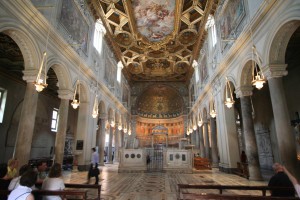
The Basilica di San Clemente is an early Christian basilica in Rome dedicated to Pope St. Clement. Its beautiful interior is especially notable for its three historical layers.
The main upper church is one of the most richly decorated churches in Rome. The vast majority of its architecture and art dates from its construction in the early 12th century. The entrance is on the left aisle.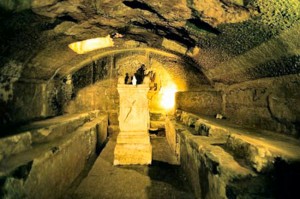
The most striking sight is the 12th-century apse mosaic, in a golden-bronze color and featuring a large cross in the center. In the center of the apse is a throne, whose back is part of a martyr’s tomb.
The high altar contains the relics of St. Clement of Rome and St. Ignatius of Antioch. Faded frescoes decorate many of the walls, and date from the 6th to 11th centuries. They depict New Testament scenes and lives of several saints.
Tags: basilica di san clemente, Church, churches in rome, clement of rome, emperor trajan, father of the church, fathers mike, mike aquilina, rome, saint clement, st clement of rome
This entry was posted on Saturday, November 23rd, 2013 at 12:02 am
You can follow any responses to this entry through the RSS 2.0 feed.
[powerpress = “devotionals-prayers”]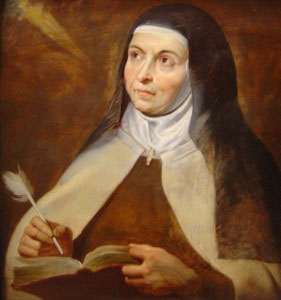
October 6 is one of my FAVORITE days, because then I can begin my official start of preparation for the commemoration of the feast of St. Teresa of Avila!!!! She is definetly ALL THAT! With all due respect, she is my spiritual prayer mama. In my most profound moment of spiritual confusion and darkness, I turned to her guidance in prayer and my life has never been the same. Now of course, the Blessed Virgin Mary is Queen above all others…that goes without saying. And absolutely our Lord Jesus Christ reigns as Our Supreme Majesty, but I really believe both of them led me to St. Teresa of Avila to guide me into a closer, deeper relationship with them both, to teach me the workings of the Holy Spirit, and ultimately, to show me how to draw closer to the heart and will of the Father….I love her!
O most amiable Lord Jesus Christ! We thank Thee for the great gift of faith and of devotion to the Holy Sacrament, which Thou didst grant to Thy beloved Teresa; we pray Thee, by Thy merits and by those of Thy faithful spouse, to grant us the gift of a lively faith, and of a fervent devotion toward the most Holy Sacrament of the altar; where Thou, O infinite Majesty! hast obliged Thyself to abide with us even to the end of the world, and wherein Thou didst so lovingly give Thy whole Self to us.
Say one Our Father, Hail Mary and Glory be.
V. St. Teresa, pray for us:
R. That we may become worthy of the promises of Jesus Christ.
Let us pray: Graciously hear us, O God of our salvation! that as we rejoice in the commemoration of the blessed virgin Teresa, so we may be nourished by her heavenly doctrine, and draw from thence the fervour of a tender devotion; through our Lord Jesus Christ, Thy Son, Who liveth and reigneth with Thee in the unity of the Holy Spirit, God for ever and ever. Amen.
This Novena was written by St. Alphonsus of Liguori.
Visit the Discerning Hearts “Teresa of Avila” page for the complete novena and text of the prayers
This entry was posted on Saturday, October 6th, 2012 at 12:24 am
You can follow any responses to this entry through the RSS 2.0 feed.
I always say a quick prayer to St. Alphonsus Ligouri before I go into the confessional. He is the great founder of the Redemptorists, and a 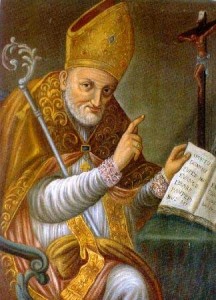 man who loved the Blessed Mother very much. His “Glories of Mary” is one of my favorite devotional books on the Blessed Virgin. He also wrote “Moral Theology”. He wrote it primarily based on his pastoral experience, as well as his education, which explains it’s ability to speak to us today. That pastoral experience, combined with his great prayer life, as well as his tremendous knowledge, made him such a wonderful confessor. What a heart this man had. He is a living example of how the journey can be made “from the head to the heart”. He is patron of Confessors and Theologians.
man who loved the Blessed Mother very much. His “Glories of Mary” is one of my favorite devotional books on the Blessed Virgin. He also wrote “Moral Theology”. He wrote it primarily based on his pastoral experience, as well as his education, which explains it’s ability to speak to us today. That pastoral experience, combined with his great prayer life, as well as his tremendous knowledge, made him such a wonderful confessor. What a heart this man had. He is a living example of how the journey can be made “from the head to the heart”. He is patron of Confessors and Theologians.
Petition to Mary by Saint Alphonsus Liguori
Most holy Virgin Immaculate, my Mother Mary,
to thee who art the Mother of my Lord,
the queen of the universe,
the advocate, the hope, the refuge of sinners,
I who am the most miserable of all sinners, have recourse this day.
I venerate thee, great queen,
and I thank thee for the many graces
thou has bestowed upon me even unto this day;
in particular for having delivered me from the hell
which I have so often deserved by my sins.
I love thee, most dear Lady;
and for the love I bear thee,
I promise to serve thee willingly forever
and to do what I can to make thee loved by others also.
I place in thee all my hopes for salvation;
accept me as thy servant
and shelter me under thy mantle,
thou who art the Mother of mercy.
And since thou art so powerful with God,
deliver me from all temptations,
or at least obtain for me the strength to overcome them until death.
From thee I implore a true love for Jesus Christ.
Through thee I hope to die a holy death.
My dear Mother,
by the love thou bearest to Almighty God,
I pray thee to assist me always,
but most of all at the last moment of my life.
Forsake me not then,
until thou shalt see me safe in heaven,
there to bless thee and sing of thy mercies through all eternity.
Such is my hope.
Amen.
Tags: blessed mother, confessor, glories of mary, moral theology, redemptorists, saint alphonsus
This entry was posted on Wednesday, August 1st, 2012 at 12:27 am
You can follow any responses to this entry through the RSS 2.0 feed.
Keys of the Kingdom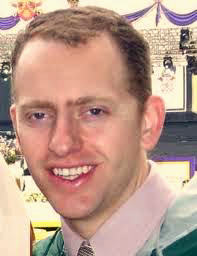
[powerpress “faith-check-with-greg-youell”]
Many of our separated brothers and sisters ask where we find a “pope†in the Bible. One example is in St. Matthew 16, where Jesus says to Peter, “I will give you the keys of the kingdom of heaven.â€1
In the ancient world, kingdoms would have a leader underneath the king who was responsible for the administration of the government—we might call them the prime ministers. We find an example of this in Isaiah 22,2 when God declares that Shebna, the Prime Minister of Israel, will be deposed for his sins and replaced by Eliakim, whom God says will be a father to Israel and will carry the key of the house of David—“what he opens none shall shut; and what he shuts none shall open.â€
When Jesus gave Peter the keys in Matthew 16, the apostles already understood their significance. Peter was to be their leader, the prime minister that will shepherd Christ’s Church. “Whatever you bind on earth shall be bound in heaven, and whatever you loose on earth shall be loosed in heaven.â€3
What a gift we have in Pope Benedict, who still carries the keys today.
1 -Â Mt. 16:19
2 -Â see Is. 22: 20-25
3 -Â Mt. 16:19
Tags: apologetics, catholic, catholic apologetics, catholic podcast, catholic prayer, cathollc spirituality, keys of the kingdom, papcy
This entry was posted on Tuesday, May 22nd, 2012 at 12:15 am
You can follow any responses to this entry through the RSS 2.0 feed.
Denver, Colo., Jan 23, 2011 / 07:09 am (CNA/EWTN News).- On Jan. 24, during the Week of Prayer for Christian Unity that runs from Jan. 18-25, Catholics will celebrate the life of St. Francis de Sales. A bishop and Doctor of the Church, his preaching brought thousands of Protestants back to the Catholic fold, and his writings on the spiritual life have proved highly influential.
The paradoxical circumstances of Francis’ birth, in the Savoy region (now part of France) during 1567, sum up several contradictory tendencies of the Church during his lifetime. The reforms of the Council of Trent had purified the Church in important ways, yet Catholics and Protestants still struggled against one another – and against the temptations of wealth and worldly power.
Francis de Sales, a diplomat’s son, was born into aristocratic wealth and privilege. Yet he was born in a room that his family named the “St. Francis room†– where there hung a painting of that saint, renowned for his poverty, preaching in the wilderness. In later years, Francis de Sales would embrace poverty also; but early in his ministry, the faithful chided him for having an aristocratic manner.
In many ways, Francis’ greatest achievements – such as the “Introduction to the Devout Life,†an
innovative spiritual guidebook for laypersons, or his strong emphasis on the role of human love in Christian devotion – represent successful attempts to re-integrate seemingly disparate “worldly†and “spiritual†realities into one coherent vision of life.
Few people, however, would have predicted these achievements for Francis during his earlier years. As a young man, he studied rhetoric, the humanities, and law. He had his law degree by age 25, and was headed for a political career. All the while, he was keeping the depths of his spiritual life – such as his profound devotion to the Virgin Mary, and his resolution of religious celibacy – a secret from the world.
Eventually, however, the truth came out, and Francis clashed with his father, who had arranged a marriage for him. The Bishop of Geneva intervened on Francis’ behalf, finding him a position in the administration of the Swiss Church that led to his priestly ordination in 1593. He volunteered to lead a mission to bring Switzerland, dominated by Calvinist Protestantism, back to the Catholic faith.
Taking on a seemingly impossible task, with only one companion – his cousin – the new priest adopted a harsh but hopeful motto: “Apostles battle by their sufferings, and triumph only in death.” It would serve him well as he traveled through Switzerland, facing many Protestants’ indifference or hostility, and being attacked by wild animals and even would-be assassins.
Some of Francis’ hearers –even, for a time, John Calvin’s protege Theodore Beza– found themselves captivated by the thoughtful, eloquent and joyful manner of the priest who implored their reunion with the Church. But he had more success when he began writing out these sermons and exhortations, slipping them beneath the doors that had been closed against him.
This pioneering use of religious tracts proved surprisingly effective at breaking down the resistance of the Swiss Calvinists, and it is estimated that between 40,000 and 70,000 of them returned to the Church through his efforts. He also served as a spiritual director, both in person and through written correspondence, with the latter format inspiring the “Introduction to the Devout Life.â€
In 1602, Francis was chosen to become the Bishop of Geneva, a position he did not seek or desire. Accepting the position, however, he gave the last twenty years of his life in ongoing sacrifice, for the restoration of Geneva’s churches and religious orders. He also helped one of his spiritual directees, the widow and future saint Jane Frances de Chantal, to found an order with a group of women.
Worn out by nearly thirty years of arduous travel and other burdens of Church leadership, Francis fell ill in 1622 while visiting one of a convent he had helped to found in Lyons. He died there, three days after Christmas that year. St. Francis de Sales was canonized in 1665, and honored as a Doctor of the Church in 1877.
Because of the crucial role of writing in his apostolate, St. Francis de Sales is the patron of writers and journalists. He is also widely credited with restoring, during his own day, a sense of what the Second Vatican Council would later call the “universal call to holiness†– that is, the notion that all people, not only those in formal religious life, are called to the heights of Christian sanctification. – CNA/EWTN News
A Prayer of St. Frances de Sales
Lord, I am yours,
and I must belong to no one but you.
My soul is yours,
and must live only by you.
My will is yours,
and must love only for you.
I must love you as my first cause,
since I am from you.
I must love you as my end and rest,
since I am for you.
I must love you more than my own being,
since my being subsists by you.
I must love you more than myself,
since I am all yours and all in you.
AMEN.
Check out other Discerning Hearts Posts on St. Francis de Sales
[p2p type=”id” value=”2622″]
[p2p type=”id” value=”2286″]
Meditations from the Introduction to the Devout Life by St. Francis de Sales
Tags: catholic, catholic podcast, catholic prayer, cathollc spirituality, doctor of the church, Francis De Sales, introduction to the devout life, spiritual guidebook, st francis de sales
This entry was posted on Tuesday, January 24th, 2012 at 12:09 am
You can follow any responses to this entry through the RSS 2.0 feed.
Nothing is Impossible with God
[powerpress]
an excerpt from today’s reflection by Don Schwager: 
The Holy Spirit gave Zechariah a vision for his own son as a prophet and forerunner who would prepare the way for the Messiah. Every devout Jew longed for the day when the Messiah would come. Now Zechariah knows beyond a doubt that that day is very near. Like Zechariah, the Holy Spirit wants to give us vision, joy, and confidence in the knowledge of God’s merciful love, protection, and care which he offers us through his Son Jesus Christ. Like the Baptist, we too are called to prepare the way that leads to Christ. Life is a journey and we are either moving towards the Lord or away from the Lord. The Lord comes to visit us each day with his life-giving Word and Spirit. Those who hunger for the Lord will not be disappointed. He will draw them to himself and show them his love and mercy.
In sending the Messiah God has made a gracious visit to his people to redeem them. This was the mission for which Jesus Christ was sent into the world — to redeem those sold for sin and sold under sin. In the feast of the Incarnation we celebrate the gracious gift of God in sending his only begotten Son to redeem us. Let us pray that the Holy Spirit may inspire us and fill us with joy and boldness to proclaim the message of the Lord’s visitation and redemption.
“Lord, you have been gracious and merciful towards your people. Fill me with your Holy Spirit that I may bear witness to the joy of the gospel to those around me.”
for the full reflection visit : Daily Reading and Meditation
Tags: catholic, catholic podcast, catholic prayer, cathollc spirituality, don schwager, gospel of luke, holy spirit, Zechariah, zechariah and elizabeth
This entry was posted on Saturday, December 24th, 2011 at 12:43 am
You can follow any responses to this entry through the RSS 2.0 feed.
“Did not our hearts burn while he opened to us the scriptures”
[powerpress feed=”daily-scripture”]
an excerpt from today’s reflection by Don Schwager: 
Why was it difficult for the disciples to recognize the risen Lord? Jesus’ death scattered his disciples and shattered their hopes and dreams. They had hoped that he was the one to redeem Israel. They saw the cross as defeat and could not comprehend the empty tomb until the Lord appeared to them and gave them understanding. Jesus chided the disciples on the road to Emmaus for their slowness of heart to believe what the scriptures had said concerning the Messiah. They did not recognize the risen Jesus until he had broken bread with them. Do you recognize the Lord in his word and in the breaking of the bread?
 St. Augustine of Hippo (5th century) reflects on the dimness of their perception: “They were so disturbed when they saw him hanging on the cross that they forgot his teaching, did not look for his resurrection, and failed to keep his promises in mind” (Sermon 235.1). “Their eyes were obstructed, that they should not recognize him until the breaking of the bread. And thus, in accordance with the state of their minds, which was still ignorant of the truth (that the Christ would die and rise again”, their eyes were similarly hindered. It was not that the truth himself was misleading them, but rather that they were themselves unable to perceive the truth.” (From The Harmony of the Gospels, 3.25.72) How often do we fail to recognize the Lord when he speaks to our hearts and opens his mind to us? The Risen Lord is ever ready to speak his word to us and to give us understanding of his ways. Do you listen attentively to the Word of God and allow his word to change and transform you?
St. Augustine of Hippo (5th century) reflects on the dimness of their perception: “They were so disturbed when they saw him hanging on the cross that they forgot his teaching, did not look for his resurrection, and failed to keep his promises in mind” (Sermon 235.1). “Their eyes were obstructed, that they should not recognize him until the breaking of the bread. And thus, in accordance with the state of their minds, which was still ignorant of the truth (that the Christ would die and rise again”, their eyes were similarly hindered. It was not that the truth himself was misleading them, but rather that they were themselves unable to perceive the truth.” (From The Harmony of the Gospels, 3.25.72) How often do we fail to recognize the Lord when he speaks to our hearts and opens his mind to us? The Risen Lord is ever ready to speak his word to us and to give us understanding of his ways. Do you listen attentively to the Word of God and allow his word to change and transform you?
“Lord Jesus Christ, open the eyes of my heart to recognize your presence with me and to understand the truth of your saving word. Nourish me with your life-giving word and with the bread of life.”
for the full reflection visit : Daily Reading and Meditation
Tags: catholic, catholic podcast, catholic prayer, cathollc spirituality
This entry was posted on Wednesday, April 27th, 2011 at 12:01 am
You can follow any responses to this entry through the RSS 2.0 feed.
The Seventh Monday in Ordinary Time – from the Gospel of Mark the full reading and reflection
“All things are possible to him who believes”
an excerpt from today’s reflection by Don Schwager: 
When Jesus rebuked the evil spirit, the boy, at first, seemed to get worse rather than better as he went into a fit of convulsion. Peter Chrysologus, a 5th century church father, reflects on this incident: “Though it was the boy who fell on the ground, it was the devil in him who was in anguish. The possessed boy was merely convulsed, while the usurping spirit was being convicted by the awesome judge. The captive was detained, but the captor was punished. Through the wrenching of the human body, the punishment of the devil was made manifest.†God promises us freedom from oppression, especially the oppression of sin and evil that rob us of faith, joy, and peace with God. The Lord invites us, as he did this boy’s father, to pray with expectant faith. Do you trust in God’s unfailing love and mercy?
The mighty works and signs which Jesus did demonstrate that the kingdom of God is present in him. These signs attest that the Father has sent him as the promised Messiah. They invite belief in Jesus as the Son of God and Savior of the world. The coming of God’s kingdom means defeat of Satan’s kingdom. Jesus’ exorcisms anticipate his great victory over “the ruler of this world” (John 12:31). While Satan may act in the world out of hatred for God and his kingdom in Christ Jesus, and may cause grave injuries of a spiritual nature, and indirectly even of a physical nature, his power is nonetheless limited and permitted by divine providence (Romans 8:28). Jesus offers freedom from bondage to sin and Satan. There is no affliction he cannot deliver us from. Do you make full use of the protection and help he offers to those who seek him with faith and trust in his mercy?
“Lord Jesus, help my unbelief! Increase my faith and trust in your saving power. Give me confidence and perseverance, especially in prayer. And help me to bring your healing love and truth to those I meet”.
for the full reflection visit : Daily Reading and Meditation
Tags: belief in Jesus, catholic, catholic podcast, catholic prayer, cathollc spirituality, don schwager, exorcisms, gospel of mark, Lord Jesus, Peter Chrysologus
This entry was posted on Monday, February 21st, 2011 at 12:35 am
You can follow any responses to this entry through the RSS 2.0 feed.
The 4th Thursday in Ordinary Time – from the Gospel of Mark the full reading and reflection
“They anointed with oil many that were sick and healed them”
an excerpt from today’s reflection by Don Schwager: 
What kind of authority and power does the Lord want you to exercise on his behalf? Jesus gave his apostles both the power and the authority to speak and to act in his name. He commanded them to do the works which he did – to heal. to cast out evil spirits, and to speak the word of God – the good news of the gospel which they received from Jesus. When Jesus spoke of power and authority he did something unheard of. He wedded power and authority with love and humility. The “world” and the “flesh” seek power for selfish gain. Jesus teaches us to use it for the good of our neighbor.
 Why does Jesus tell the apostles to “travel light” with little or no provision? “Poverty of spirit” frees us from greed and preoccupation with possessions and makes ample room for God’s provision. The Lord wants his disciples to be dependent on him and not on themselves. He wills to work through and in each of us for his glory. Are you ready to handle the power and authority which God wishes you to exercise on his behalf? The Lord entrusts us with his gifts and talents. Are you eager to place yourself at his service, to do whatever he bids you, and to witness his truth and saving power to whomever he sends you?
Why does Jesus tell the apostles to “travel light” with little or no provision? “Poverty of spirit” frees us from greed and preoccupation with possessions and makes ample room for God’s provision. The Lord wants his disciples to be dependent on him and not on themselves. He wills to work through and in each of us for his glory. Are you ready to handle the power and authority which God wishes you to exercise on his behalf? The Lord entrusts us with his gifts and talents. Are you eager to place yourself at his service, to do whatever he bids you, and to witness his truth and saving power to whomever he sends you?
“Lord Jesus, make me a channel of your grace and healing love that others may find life and freedom in you. Free me from all other attachments that I may joyfully pursue the things of heaven. May I witness the joy of the gospel both in word and deed.”
for the full reflection visit : Daily Reading and Meditation
Tags: catholic, catholic podcast, catholic prayer, cathollc spirituality, disciples, don schwager, gospel of mark
This entry was posted on Thursday, February 3rd, 2011 at 5:04 am
You can follow any responses to this entry through the RSS 2.0 feed.
Debra Herbeck has compiled a compelling selection of reflections from sai nts and writers who have suffered, who were tempted to depair, and who were tested in everyway, but through grace and faith, they never gave up. Hope, a viture we can’t live without. If you or someone you know is suffering through hard times, “Safely Through the Storm” is for you.
nts and writers who have suffered, who were tempted to depair, and who were tested in everyway, but through grace and faith, they never gave up. Hope, a viture we can’t live without. If you or someone you know is suffering through hard times, “Safely Through the Storm” is for you.
[powerpress]
Tags: catholic, catholic podcast, catholic prayer, cathollc spirituality
This entry was posted on Monday, January 3rd, 2011 at 9:20 pm
You can follow any responses to this entry through the RSS 2.0 feed.
Fourth Sunday of Advent Cycle AÂ – from the Gospel of Matthew the full reading and reflection
“He will save his people from their sins”
an excerpt from today’s reflection by Don Schwager: 
The new era of salvation begins with the conception of Jesus in the womb of Mary by the power of the Holy Spirit. This child to be born is the fulfillment of all God’s promises.
Mary had to face an enormous challenge to her faith and trust in God and to the faith of her family and Joseph, the man she chose to marry. She was asked to assume a burden of tremendous responsibility. It had never been heard of before that a child could be born without a natural father. Mary was asked to accept this miraculous exception to the laws of nature. That required faith and trust in God and in his promises. Second, Mary was not yet married. Pregnancy outside of wedlock was not tolerated in those days. Mary was only espoused to Joseph, and such an engagement had to last for a whole year. She was asked to assume a great risk. She could have been rejected by Joseph, by her family, by all her own people. Mary knew that Joseph and her family would not understand without revelation from God. She nonetheless believed and trusted in God’s promises.
 Joseph, a just and God-fearing man, did not wish to embarrass or punish his espoused wife, Mary when he discovered that she was pregnant. To all appearances she had broken their solemn pledge to be faithful and chaste to one another. Joseph, no doubt took this troubling matter to God in prayer. He was not hasty to judge or to react with hurt and anger. God rewarded him not only with guidance and consolation, but with the divine assurance that he had indeed called Joseph to be the husband of Mary and to assume a mission that would require the utmost faith, confidence, and trust in Almighty God. Joseph believed in the divine message to take Mary as his wife and to accept the child in her womb as the promised Messiah. Like Mary, Joseph is a model of faith for us. He is a faithful witness and servant of God’s unfolding plan of redemption. Are you ready to believe in the promises of God, even when faced with perplexing circumstances and what seems like insurmountable problems? God has not left us alone, but has brought us his only begotten Son, our Lord and Savior Jesus Christ. Let us celebrate Christmas, the feast of the Incarnation, with joyful hearts and let us renew our faith and hope in God and in his redeeming work.
Joseph, a just and God-fearing man, did not wish to embarrass or punish his espoused wife, Mary when he discovered that she was pregnant. To all appearances she had broken their solemn pledge to be faithful and chaste to one another. Joseph, no doubt took this troubling matter to God in prayer. He was not hasty to judge or to react with hurt and anger. God rewarded him not only with guidance and consolation, but with the divine assurance that he had indeed called Joseph to be the husband of Mary and to assume a mission that would require the utmost faith, confidence, and trust in Almighty God. Joseph believed in the divine message to take Mary as his wife and to accept the child in her womb as the promised Messiah. Like Mary, Joseph is a model of faith for us. He is a faithful witness and servant of God’s unfolding plan of redemption. Are you ready to believe in the promises of God, even when faced with perplexing circumstances and what seems like insurmountable problems? God has not left us alone, but has brought us his only begotten Son, our Lord and Savior Jesus Christ. Let us celebrate Christmas, the feast of the Incarnation, with joyful hearts and let us renew our faith and hope in God and in his redeeming work.
“Lord Jesus, you came to save us from sin and the power of death. May I always rejoice in your salvation and trust in your plan for my life”.
for the full reflection visit : Daily Reading and Meditation
Tags: catholic, catholic podcast, catholic prayer, cathollc spirituality, don schwager, fourth sunday of advent, gospel of matthew, joseph, mary
This entry was posted on Sunday, December 19th, 2010 at 6:22 am
You can follow any responses to this entry through the RSS 2.0 feed.
A special “reflection” by my pal, Omar F. A. Gutierrez. be sure to visit his blog at Regnum Novum
S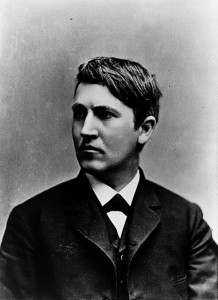 o I’m awoken on Friday morning of February 11th with a voice resembling that belonging to my friend Kris on the other end of the phone asking, “Did I wake you?†“No, no,†I answer while thinking to myself that I’d like to be the sort of person who should be up at this hour anyway.
o I’m awoken on Friday morning of February 11th with a voice resembling that belonging to my friend Kris on the other end of the phone asking, “Did I wake you?†“No, no,†I answer while thinking to myself that I’d like to be the sort of person who should be up at this hour anyway.
My friend continues, “What did you do to your website?†The question befuddles me. I’ve been fretting over the thing lately. I haven’t done anything I think to myself, but get off my back, and why are you calling me at this hour? She goes on to tell me that my counter, the thingy at the bottom of my site that counts the number of visits or hits I’ve received anywhere on my website, has shot through the roof. I had remembered checking it a couple days before. It was around 53,000. Kris, for it is Kris McGregor, tells me it is now at around 129,000. Something’s up. People from all over the world are downloading the series Kris and I are doing on the social doctrine of the Church: the Netherlands, Poland, Australia. “The Netherlands!†she says. I’m out of bed.
When I get downstairs to my computer to check the stats on my page, I find that, indeed thousands of people have visited my website in just the last few hours. Most of them spend only fleeting seconds on it. But some stay. Some read. Some move onto Kris’s website Discerning Hearts and download the series and then stay to download other things, devotionals and interviews. Who are these people from Italy, Spain, Venezuela, France, Germany? Why are they coming to my website? What is going on?
This whole technology thing is still pretty new to me. I was just thinking the other day how adamant I was at the ripe old age of twelve not to convert my extensive audio tape collection to CD. Those new-fangled CD’s were just a fad, I told myself. It’ll pass. Staunchly through high school I developed my tape collection. It was an impressive heap of blues and classic rock with smatterings of grunge and the entirety of the U2 oeuvre including some bootlegged concert audio.
Eventually I did break down and buy CD’s but I didn’t like it. In this new post-CD age, where everything is on the computer and downloadable onto iPods and the like, I am happy to say that I am without a gigantic CD collection, nothing like those grad-school friends of mine who’s collections could cover the entire wall of a oppressively undersized apartment. And my tapes? I like to believe that they are collector’s-item-cool now, just waiting to be taken onto the Antique Road Show in 2041 where I’ll be told I have the only existing audio cassette with U2′s 1987 Miami show. A guy can dream.
Thomas Alva Edison (1847-1931)
Blogging is a new thing to me as well, and I’ve eased into it with much help from Kris who seems to have her pulse on everything chic and contemporary. She’s the lady in the know. Me, I’m just the guy with glasses who in high school liked to sit over a copy of St. Augustine’s De Trinitate. It was my own little rebellion against the world of MTV, Beavis, and Butthead.
I am even more clueless about how to track down the people who come to my website. But there are programs for this, programs Kris tells me to get, and which I get, and which do blow me away in their specificity.
Hitsniffer, for instance, can tell you who is on your website, what city they live in, what they are looking at right now, how long they’ve been on your website, etc. Have you ever wondered how it is that a website can target advertisements to you and use your city’s name in it? We have the technology, and the technology as at our fingertips.
Now, granted, there is a bit of ick-factor in all of this. How much information is too much? Can I pinpoint an address? Can religious affiliation be determined by IP addresses? Well no. Don’t worry. There is no way I could track down any such information. And anyway, I wouldn’t know how to use the technology even if there were a way. What I did glean from the programs was that people were flocking to my website from all over the world to the tune of 600 to 800 people at a time. I mean that that many people were on my site at the same time. They were all new visitors and not repeats. Furthermore, there was no referring site from which they came except that they were all looking for information on Thomas Edison.
Thomas Edison? I had included a picture of old Tom on a post I had some months ago. “The Myth of the Self-Made Man†it was titled. I thought it was a rather uniquely catchy title myself. If you Google the phrase, however, you won’t find my post anywhere near the top. Anyway, for some time now, I had been getting hits on my website from people doing a search for Thomas Edison, probably for a picture of him, and finding my website as a source for just such a picture. There were a couple every day, but not huge numbers. The most visits I had ever gotten in a single day was something like 70. On this day I had 800 visitors in two minutes… all of them looking for Thomas Edison.
I wracked my brain to come up with some explanation of this. Perhaps someone famous had read one of my posts or heard the social doctrine series with Kris and linked it. Maybe, this was not about Edison at all. Maybe some wise figurehead of a faraway Catholic empire had read my post and was passing it around as mandatory reading for those who wanted to be in the know…like Kris. Or perhaps an e-mail was sent around to influential people, and I had “gone viral.†(I’m still not sure what this means or why it’s good, but I’m told that is the appropriately technical language to use in these cases.) .
By mid-day, and without much headway in solving the mystery, I finally just had it. I changed the post with the picture of Thomas Edison to read at the top, “If this is your first visit to Regnum Novum, welcome! Please let me know how you heard of this site as I am getting a lot of traffic. Please send me an e-mail or leave a comment.†When in doubt, ask. So I did.
The answer was pretty astonishing to me, and was proffered by two visitors.
Apparently, February 11th, 2011 was the 164th birthday of Thomas Edison. Google, which on holidays or memorable days sometimes puts up a special picture to spell out Google, put up a “doodle†to mark this fact of Edison’s birthday. If you clicked on the “doodle,†you were sent to a listing of all sorts of sources on Thomas Edison and a bar of pictures of the man. The most prominent of these pictures, a dashing photo of the man’s head and upper chest (seen to the left here), was the fourth one from the left, and was indeed the picture I had used on my site. If you clicked on it, the picture would come up on the screen and behind it, translucent and ethereal, was my website.
So of the global millions that day who used Google, millions clicked on the “doodle.†Of those, some fewer factor of millions looked at the pictures. Of those, perhaps hundreds of thousands liked the picture I used and clicked on it. Of those, some saw the title of the post partially obscured so that it read, “The Myth of the Self-Mad.†They would have also seen “Theology on Tap,†and “New Evangelization through Social Doctrine.†Thus, with interest and curiosity peaked, tens of thousands saw the picture and noticed the website and about 150,000 clicked on it… clicked on my website… behind the photo. Of those, several thousand explored the site and hundreds moved on to Kris McGregor’s site to – among other things – download the series on social doctrine…
…and all of it because of a picture of Thomas Edison.
Since then I cannot help but wonder in amazement for the great and glorious God that we have. Through happenstance? Through kismet? Through serendipity? No through the ever-loving guiding hand of the Almighty, thousands were exposed to my writings and to the work that I am doing with Kris to explain the social doctrine of the Church.Yes the lilies of the field are dressed in splendid robes. Me? I should trust, for He is always looking out for my good.
This mystery and miracle have certainly taught me a great deal about the power of technology as well, and this has given me greater appreciation for the words of the Holy Father Pope Benedict XVI in April of last year:
Without fear we want to set out upon the digital sea embracing the unrestricted navigation with the same passion that for 2,000 years has steered the barque of the Church. More than with technical resources, although necessary, we want to qualify ourselves dwelling in this universe too with a believing heart, that contributes to giving a soul to the uninterrupted communicational flow of the Internet.
May we all be so bold as to put out into the digital sea, all the while knowing that it is not we who man the barque of the Church but Peter and the Spirit of God.
Tags: catholic, catholic podcast, catholic prayer, cathollc spirituality, Thomas Alva Edison, thomas edison
This entry was posted on Wednesday, December 15th, 2010 at 6:39 am
You can follow any responses to this entry through the RSS 2.0 feed.
1. Why do we celebrate Advent? What does it mean and what’s it all about?
2. What is the significance of the Advent Wreath, the nativity set, the different colors, etc. we see in Church?
[powerpress]
Mark Hart is an author, speaker, director and teacher, Mark’s work both written and spoken, is known across the country and world. While he serves as the Vice President of LIFE TEEN, he is known to tens of thousands simply as the “Bible Geek ®†Mark passionately echoes the gospel to all he encounters. He is as deep as he is funny, and his love for his wife and daughters is second only to his immense love for Jesus Christ.
Visit Mark at www.lifeteen.com
Tags: Advent Mark answers, advent wreath, bible, catholic, catholic podcast, catholic prayer, cathollc spirituality, life teen, love, mark hart, nativity, sacred scripture, why do we celebrate advent
This entry was posted on Sunday, November 28th, 2010 at 9:19 am
You can follow any responses to this entry through the RSS 2.0 feed.
According to the Catholic Encyclopedia, the origins of Corpus Christi can be traced to St. Juliana of Mount Cornillon.
From Pope Benedict’s General Audience from vatican.va
Dear Brothers and Sisters,
This morning too I would like to introduce a female figure to you. She is little known but the Church is deeply indebted to her, not only because of the holiness of her life but also because, with her great fervour, she contributed to the institution of one of the most important solemn Liturgies of the year:Â Corpus Christi.
She is St Juliana de Cornillon, also known as St Juliana of Liège. We know several facts about her life, mainly from a Biography that was probably written by a contemporary cleric; it is a collection of various testimonies of people who were directly acquainted with the Saint.
Juliana was born near Liège, Belgium between 1191 and 1192. It is important to emphasize this place because at that time the Diocese of Liège was, so to speak, a true “Eucharistic Upper Roomâ€. Before Juliana, eminent theologians had illustrated the supreme value of the Sacrament of the Eucharist and, again in Liège, there were groups of women generously dedicated to Eucharistic worship and to fervent communion. Guided by exemplary priests, they lived together, devoting themselves to prayer and to charitable works.
Orphaned at the age of five, Juliana, together with her sister Agnes, was entrusted to the care of the Augustinian nuns at the convent and leprosarium of Mont-Cornillon.
She was taught mainly by a sister called “Sapienza†[wisdom], who was in charge of her spiritual development to the time Juliana received the religious habit and thus became an Augustinian nun.
She became so learned that she could read the words of the Church Fathers, of St Augustine and St Bernard in particular, in Latin. In addition to a keen intelligence, Juliana showed a special propensity for contemplation from the outset. She had a profound sense of Christ’s presence, which she experienced by living the Sacrament of the Eucharist especially intensely and by pausing frequently to meditate upon Jesus’ words: “And lo, I am with you always, to the close of the age†(Mt 28:20).
When Juliana was 16 she had her first vision which recurred subsequently several times during her Eucharistic adoration. Her vision presented the moon in its full splendour, crossed diametrically by a dark stripe. The Lord made her understand the meaning of what had appeared to her. The moon symbolized the life of the Church on earth, the opaque line, on the other hand, represented the absence of a liturgical feast for whose institution Juliana was asked to plead effectively: namely, a feast in which believers would be able to adore the Eucharist so as to increase in faith, to advance in the practice of the virtues and to make reparation for offences to the Most Holy Sacrament.
Juliana, who in the meantime had become Prioress of the convent, kept this revelation that had filled her heart with joy a secret for about 20 years. She then confided it to two other fervent adorers of the Eucharist, Blessed Eva, who lived as a hermit, and Isabella, who had joined her at the Monastery of Mont-Cornillon. The three women established a sort of “spiritual alliance†for the purpose of glorifying the Most Holy Sacrament.
They also chose to involve a highly regarded Priest, John of Lausanne, who was a canon of the Church of St Martin in Liège. They asked him to consult theologians and clerics on what was important to them. Their affirmative response was encouraging.
What happened to Juliana of Cornillon occurs frequently in the lives of Saints. To have confirmation that an inspiration comes from God it is always necessary to be immersed in prayer to wait patiently, to seek friendship and exchanges with other good souls and to submit all things to the judgement of the Pastors of the Church.
It was in fact Bishop Robert Torote, Liège who, after initial hesitation, accepted the proposal of Juliana and her companions and first introduced the Solemnity of Corpus Christi in his diocese. Later other Bishops following his example instituted this Feast in the territories entrusted to their pastoral care.
However, to increase their faith the Lord often asks Saints to sustain trials. This also happened to Juliana who had to bear the harsh opposition of certain members of the clergy and even of the superior on whom her monastery depended.
Of her own free will, therefore, Juliana left the Convent of Mont-Cornillon with several companions. For 10 years — from 1248 to 1258 — she stayed as a guest at various monasteries of Cistercian sisters.
She edified all with her humility, she had no words of criticism or reproach for her adversaries and continued zealously to spread Eucharistic worship.
She died at Fosses-La-Ville, Belgium, in 1258. In the cell where she lay the Blessed Sacrament was exposed and, according to her biographer’s account, Juliana died contemplating with a last effusion to love Jesus in the Eucharist whom she had always loved, honoured and adored. Jacques Pantaléon of Troyes was also won over to the good cause of the Feast of Corpus Christi during his ministry as Archdeacon in Lièges. It was he who, having become Pope with the name of Urban iv in 1264, instituted the Solemnity of Corpus Christi on the Thursday after Pentecost as a feast of precept for the universal Church.
In the Bull of its institution, entitled Transiturus de hoc mundo, (11 Aug. 1264), Pope Urban even referred discreetly to Juliana’s mystical experiences, corroborating their authenticity. He wrote: “Although the Eucharist is celebrated solemnly every day, we deem it fitting that at least once a year it be celebrated with greater honour and a solemn commemoration.
“Indeed we grasp the other things we commemorate with our spirit and our mind, but this does not mean that we obtain their real presence. On the contrary, in this sacramental commemoration of Christ, even though in a different form, Jesus Christ is present with us in his own substance. While he was about to ascend into Heaven he said ‘And lo, I am with you always, to the close of the age’ (Matthew 28:20)â€.
The Pontiff made a point of setting an example by celebrating the solemnity of Corpus Christi in Orvieto, the town where he was then residing. Indeed, he ordered that the famous Corporal with the traces of the Eucharistic miracle which had occurred in Bolsena the previous year, 1263, be kept in Orvieto Cathedral — where it still is today.
While a priest was consecrating the bread and the wine he was overcome by strong doubts about the Real Presence of the Body and Blood of Christ in the sacrament of the Eucharist. A few drops of blood began miraculously to ooze from the consecrated Host, thereby confirming what our faith professes.
Urban iv asked one of the greatest theologians of history, St Thomas Aquinas — who at that time was accompanying the Pope and was in Orvieto — to compose the texts of the Liturgical Office for this great feast. They are masterpieces, still in use in the Church today, in which theology and poetry are fuse. These texts pluck at the heartstrings in an expression of praise and gratitude to the Most Holy Sacrament, while the mind, penetrating the mystery with wonder, recognizes in the Eucharist the Living and Real Presence of Jesus, of his Sacrifice of love that reconciles us with the Father, and gives us salvation.
Although after the death of Urban iv the celebration of the Feast of Corpus Christi was limited to certain regions of France, Germany, Hungary and Northern Italy, it was another Pontiff, John xxii, who in 1317 re-established it for the universal Church. Since then the Feast experienced a wonderful development and is still deeply appreciated by the Christian people.
I would like to affirm with joy that today there is a “Eucharistic springtime†in the Church: How many people pause in silence before the Tabernacle to engage in a loving conversation with Jesus! It is comforting to know that many groups of young people have rediscovered the beauty of praying in adoration before the Most Blessed Sacrament.
I am thinking, for example, of our Eucharistic adoration in Hyde Park, London. I pray that this Eucharistic “springtime†may spread increasingly in every parish and in particular in Belgium, St Juliana’s homeland.
Venerable John Paul II said in his Encyclical Ecclesia de Eucharistia: “In many places, adoration of the Blessed Sacrament is also an important daily practice and becomes an inexhaustible source of holiness. The devout participation of the faithful in the Eucharistic procession on the Solemnity of the Body and Blood of Christ is a grace from the Lord which yearly brings joy to those who take part in it. Other positive signs of Eucharistic faith and love might also be mentioned†(n. 10).
In  remembering St Juliana of Cornillon let us also renew our faith in the Real Presence of Christ in the Eucharist. As we are taught by the Compendium of the Catechism of the Catholic Church,“Jesus Christ is present in the Eucharist in a unique and incomparable way. He is present in a true, real and substantial way, with his Body and his Blood, with his Soul and his Divinity. In the Eucharist, therefore, there is present in a sacramental way, that is, under the Eucharistic Species of bread and wine, Christ whole and entire, God and Man†(n. 282).
Dear friends, fidelity to the encounter with the Christ in the Eucharist in Holy Mass on Sunday is essential for the journey of faith, but let us also seek to pay frequent visits to the Lord present in the Tabernacle! In gazing in adoration at the consecrated Host, we discover the gift of God’s love, we discover Jesus’ Passion and Cross and likewise his Resurrection. It is precisely through our gazing in adoration that the Lord draws us towards him into his mystery in order to transform us as he transforms the bread and the wine.
The Saints never failed to find strength, consolation and joy in the Eucharistic encounter. Let us repeat before the Lord present in the Most Blessed Sacrament the words of the Eucharistic hymn “Adoro te devoteâ€: [Devoutly I adore Thee]: Make me believe ever more in you, “Draw me deeply into faith, / Into Your hope, into Your loveâ€.
Thank you.
Tags: catholic, catholic podcast, catholic prayer, cathollc spirituality, corpus christi, feast of corpus christi, feast of the blessed sacrament, saint augustine
This entry was posted on Wednesday, November 17th, 2010 at 5:33 pm
You can follow any responses to this entry through the RSS 2.0 feed.

